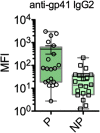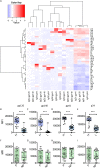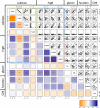Divergent antibody subclass and specificity profiles but not protective HLA-B alleles are associated with variable antibody effector function among HIV-1 controllers
- PMID: 24352471
- PMCID: PMC3958053
- DOI: 10.1128/JVI.03130-13
Divergent antibody subclass and specificity profiles but not protective HLA-B alleles are associated with variable antibody effector function among HIV-1 controllers
Abstract
Understanding the coordination between humoral and cellular immune responses may be the key to developing protective vaccines, and because genetic studies of long-term HIV-1 nonprogressors have associated specific HLA-B alleles with spontaneous control of viral replication, this subject group presents an opportunity to investigate relationships between arms of the adaptive immune system. Given evidence suggesting that cellular immunity may play a role in viral suppression, we sought to determine whether and how the humoral immune response might vary among controllers. Significantly, Fc-mediated antibody effector functions have likewise been associated with durable viral control. In this study, we compared the effector function and biophysical features of HIV-specific antibodies in a cohort of controllers with and without protective HLA-B alleles in order to investigate whether there was evidence for multiple paths to HIV-1 control, or whether cellular and humoral arms of immunity might exhibit coordinated profiles. However, with the exception of IgG2 antibodies to gp41, HLA status was not associated with divergent humoral responses. This finding did not result from uniform antibody responses across subjects, as controllers could be regrouped according to strong differences in their HIV-specific antibody subclass specificity profiles. These divergent antibody profiles were further associated with significant differences in nonneutralizing antibody effector function, with levels of HIV-specific IgG1 acting as the major distinguishing factor. Thus, while HLA background among controllers was associated with minimal differences in humoral function, antibody subclass and specificity profiles were associated with divergent effector function, suggesting that these features could be used to make functional predictions. Because these nonneutralizing antibody activities have been associated with spontaneous viral control, reduced viral load, and nonprogression in infected subjects and protection in vaccinated subjects, understanding the specific features of IgGs with potentiated effector function may be critical to vaccine and therapeutic antibody development.
Importance: In this study, we investigated whether the humoral and cellular arms of adaptive immunity exhibit coordinated or compensatory activity by studying the antibody response among HIV-1 controllers with different genetic backgrounds.
Figures






Similar articles
-
Temporal variation in HIV-specific IgG subclass antibodies during acute infection differentiates spontaneous controllers from chronic progressors.AIDS. 2018 Feb 20;32(4):443-450. doi: 10.1097/QAD.0000000000001716. AIDS. 2018. PMID: 29239894 Free PMC article.
-
HIV type 1-specific IgG2 antibodies: markers of helper T cell type 1 response and prognostic marker of long-term nonprogression.AIDS Res Hum Retroviruses. 2001 Oct 10;17(15):1435-46. doi: 10.1089/088922201753197105. AIDS Res Hum Retroviruses. 2001. PMID: 11679156
-
Isotype-switched immunoglobulin G antibodies to HIV Gag proteins may provide alternative or additional immune responses to 'protective' human leukocyte antigen-B alleles in HIV controllers.AIDS. 2013 Feb 20;27(4):519-28. doi: 10.1097/QAD.0b013e32835cb720. AIDS. 2013. PMID: 23364441
-
Humoral immunity in HIV-1 post-treatment controllers.Curr Opin HIV AIDS. 2025 Jan 1;20(1):80-85. doi: 10.1097/COH.0000000000000893. Epub 2024 Nov 7. Curr Opin HIV AIDS. 2025. PMID: 39633540 Review.
-
Effector mechanisms in HIV-1 infected elite controllers: highly active immune responses?Antiviral Res. 2010 Jan;85(1):295-302. doi: 10.1016/j.antiviral.2009.08.007. Epub 2009 Sep 4. Antiviral Res. 2010. PMID: 19733595 Free PMC article. Review.
Cited by
-
Elevated IgG4 in patient circulation is associated with the risk of disease progression in melanoma.Oncoimmunology. 2015 Jun 3;4(11):e1032492. doi: 10.1080/2162402X.2015.1032492. eCollection 2015 Nov. Oncoimmunology. 2015. PMID: 26451312 Free PMC article.
-
Modulating Antibody Functionality in Infectious Disease and Vaccination.Trends Mol Med. 2016 Nov;22(11):969-982. doi: 10.1016/j.molmed.2016.09.002. Epub 2016 Oct 15. Trends Mol Med. 2016. PMID: 27756530 Free PMC article. Review.
-
Association of HIV-1 Gag-Specific IgG Antibodies With Natural Control of HIV-1 Infection in Individuals Not Carrying HLA-B*57: 01 Is Only Observed in Viremic Controllers.J Acquir Immune Defic Syndr. 2017 Nov 1;76(3):e90-e92. doi: 10.1097/QAI.0000000000001477. J Acquir Immune Defic Syndr. 2017. PMID: 28604502 Free PMC article.
-
Viremic HIV Controllers Exhibit High Plasmacytoid Dendritic Cell-Reactive Opsonophagocytic IgG Antibody Responses against HIV-1 p24 Associated with Greater Antibody Isotype Diversification.J Immunol. 2015 Jun 1;194(11):5320-8. doi: 10.4049/jimmunol.1402918. Epub 2015 Apr 24. J Immunol. 2015. PMID: 25911748 Free PMC article.
-
Differences in serum IgA responses to HIV-1 gp41 in elite controllers compared to viral suppressors on highly active antiretroviral therapy.PLoS One. 2017 Jul 3;12(7):e0180245. doi: 10.1371/journal.pone.0180245. eCollection 2017. PLoS One. 2017. PMID: 28671952 Free PMC article.
References
-
- Fellay J, Shianna KV, Ge D, Colombo S, Ledergerber B, Weale M, Zhang K, Gumbs C, Castagna A, Cossarizza A, Cozzi-Lepri A, De Luca A, Easterbrook P, Francioli P, Mallal S, Martinez-Picado J, Miro JM, Obel N, Smith JP, Wyniger J, Descombes P, Antonarakis SE, Letvin NL, McMichael AJ, Haynes BF, Telenti A, Goldstein DB. 2007. A whole-genome association study of major determinants for host control of HIV-1. Science 317:944–947. 10.1126/science.1143767 - DOI - PMC - PubMed
Publication types
MeSH terms
Substances
Grants and funding
LinkOut - more resources
Full Text Sources
Other Literature Sources
Medical
Research Materials

